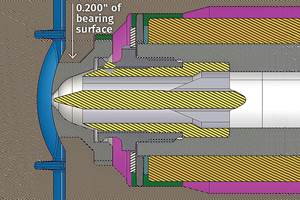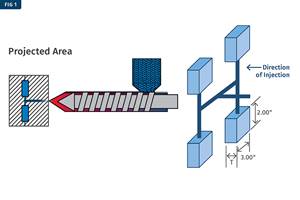Finagling the Flow: Making Viscosity Work For You In Molding
Viscosity represents a broad concept with huge effects on any efforts to standardize an injection molding process. It is also one of the most important weapons in a molder’s arsenal for making process changes.
Viscosity represents a broad concept with huge effects on any efforts to standardize an injection molding process. It is also one of the most important weapons in a molder’s arsenal for making process changes.
This article will first explain viscosity, and then delve into different situations where it may help or be hurt the goals of zero scrap and high output. It is important to understand that viscosity can be both an effective tool, and a cause for failure, as processors strive to optimize and standardize processes.
Viscosity: Viscosity as it relates to plastic injection is the measurement of how thick or thin a material flows. A good comparison would be the difference between molasses and water. If you were to pour water and molasses at the same time, water would flow much more easily than the molasses. Molasses is thick, and flows slowly. Water is thinner, and flows much faster. Molasses would be considered to be high viscosity, and water would be low viscosity.
The same terminology applies to different materials in injection molding. Materials that are low viscosity flow thinly and quickly, while high viscosity materials flow thickly and slowly. For instance, nylon flows thinner and faster than styrene, thus nylon has a lower viscosity than styrene. Styrene falls in the middle of the material scale, and is considered to be the mean. As such, materials that are at a higher viscosity than styrene are recorded as positive. Materials that are a lower viscosity than styrene are recorded in MSDS data with negative values.
Viscosity vs. Temperature
Temperature plays an important role in adjusting viscosity, under these general rules of thumb: Adding heat will lower the viscosity of a material, boosting the speed of flow. It is important to note here, however, that higher temperatures add to cycle time, and there is a point when higher temperature becomes detrimental to a process by producing more gas and causing material degradation. Melt temperature should be measured to assure that barrel temperature are within the tolerances of the melt window provided by the machine manufacturer.
Reducing heat thickens the flow and slows down the fill rate. Lower temperatures provide faster cycle times, but increase wear on plastics equipment if the temperature becomes too low. Again, it is important to measure melt temperature to verify that heats are within the melt window.
Viscosity vs. Fill Time
Viscosity has little effect on fill time. Thinner flow fronts flow more easily, however injection speed is established through scientific procedure to be at the mean of slow to fast. The press controls the speed using valves, servos, etc. There is, however, a change in the amount of energy used to satisfy what set points establish as the correct fill speed. Increased energy usage can sometimes result in higher production cost, and vice versa for energy decreases. There are situations where one or the other may become more beneficial based on higher production needs or value costing.
Viscosity vs. Peak Pressure
Viscosity also has a direct relationship to peak pressure. A thicker, cooler flow front will result in a higher peak pressure. A thinner, warmer flow front results in a lower peak pressure. Thus, adding heat lowers viscosity and peak pressure while reducing heat increases viscosity and peak pressure.
Using Viscosity to Address Defects
Several common molding defects can be addressed using viscosity changes. To be clear, this article is not advocating that viscosity can be the cure all for molding defects, but there are situations where adjusting viscosity can improve part functions and/or appearance. Listed here are many of these situations, and methods of using viscosity to improve upon or eliminate the defect:
Sink: There are several different types of sink, but heat sink and sinks over ribs or deep contours in the mold design can have a direct relationship to viscosity.
Heat sink occurs when mold or material temperature is too hot. Cycle time can also be a factor. In some instances, lowering barrel temperature can reduce or eliminate heat sink conditions.
Sink over ribs/details: Sinks over ribs can be related to two different situations:
Material in the rib can still be too hot, leading to a sink over the rib. In this case, lowering viscosity may improve the condition by lowering heat in the rib area.
Sink can also be caused by material flowing across the rib too slowly, leading to an over-pack condition that causes a pull sink as the part ejects. In this situation, increasing heat can promote thinner flow, flowing faster across the rib and packing it out less. As the part ejects, the rib being packed less allows for better removal of the part.
Flash: There are several situations where flash can be directly attributed to viscosity. For instance, hair line flash can be a sure sign that material is too viscous and a temperature reduction is needed to improve the condition. In some situations where a mold has parting line damage, reducing heat can actually improve flash that was a direct result of that damage.
Knit Lines: These occur when different flow fronts come together as plastic flows through the part cavities. In the case of mold details, knits will occur on the lee side of a detail. Picture a rock in a stream—as the water rushes against it, the rock causes resistance. The water flows around the rock, knitting back together as the two flow fronts meet each other in the rear.
The faster the water flows, the longer it takes for the two flow streams to reassemble as one. The same applies when molding around a detail. Faster flow results in longer, thinner knits. Slower flow results in thicker and shorter knits. In terms of viscosity, higher heat equals faster flow and lower heat equals slower flow. If packing around a detail is causing cracks/ shorts/burns on the knit line, reduce the heat to improve knit line seal and strength.
As noted above, there are many situations where viscosity can be used as a tool to correct poor molding conditions. When standardizing a process, start off with lower level viscosity as determined by melt temperature, and then make adjustments using higher temperatures when viscosity appears to be directly related to molding issues. This assures that cycle times are optimal, thus leading to higher efficiency. Low scrap and high efficiency will lead to higher returns off of your molded products.
Related Content
Three Key Decisions for an Optimal Ejection System
When determining the best ejection option for a tool, molders must consider the ejector’s surface area, location and style.
Read MoreUse These 7 Parameters to Unravel the Melt Temperature Mystery
Despite its integral role in a stable process and consistent parts, true melt temperature in injection molding can be an enigma. Learning more about these seven parameters may help you solve the puzzle.
Read MoreHot Runners: Truths. Myths, Overlooked Areas: Part 2
Here’s a view from the trenches of a tooling manager who, over 30 years, has experienced the joys and pains of using virtually every type of hot runner on the market. Part 2.
Read MoreIs There a More Accurate Means to Calculate Tonnage?
Molders have long used the projected area of the parts and runner to guesstimate how much tonnage is required to mold a part without flash, but there’s a more precise methodology.
Read MoreRead Next
Lead the Conversation, Change the Conversation
Coverage of single-use plastics can be both misleading and demoralizing. Here are 10 tips for changing the perception of the plastics industry at your company and in your community.
Read MoreBeyond Prototypes: 8 Ways the Plastics Industry Is Using 3D Printing
Plastics processors are finding applications for 3D printing around the plant and across the supply chain. Here are 8 examples to look for at NPE2024.
Read More












